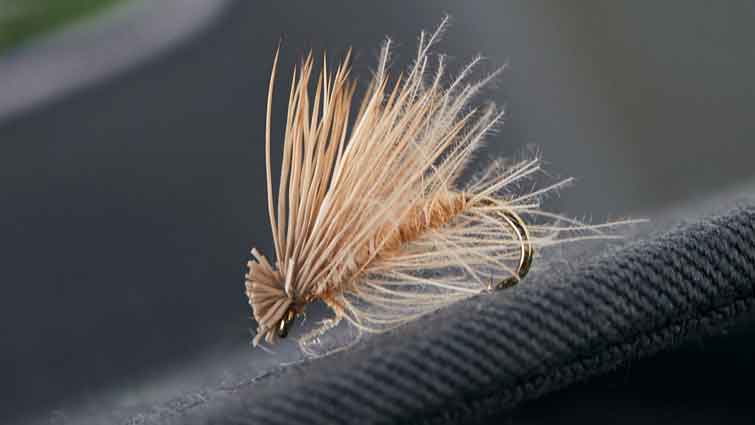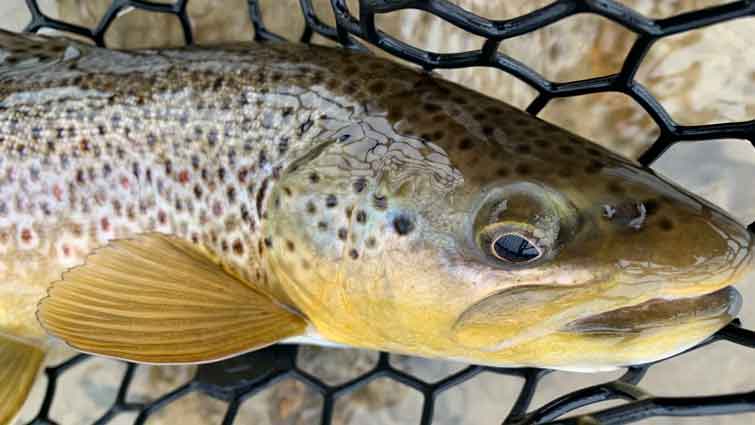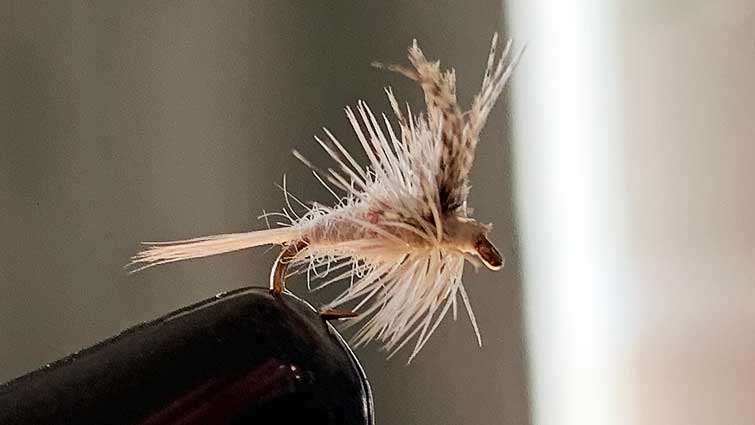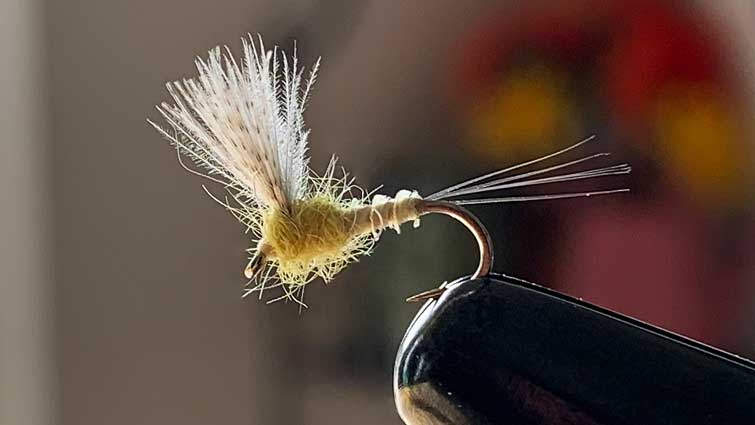Dry flies are typically light, feathered flies that are designed to imitate adult insects in the water. Dry flies generally float on the surface of the water, and they can be made from a variety of materials.
The best dry fly will vary depending on where you fish and what kinds of conditions prevail in your area, as well as the current hatch. You should select a fly based on current weather conditions in your area - if it's windy or rainy, a floating line will make it easier to cast small flies accurately.
The best size dry fly for trout is generally sized 12-18 but some patterns can be fished even as small as 20-22. Even when caddis are hatching, instead of mayflies, these sized dry flies will draw strikes. The best size dry fly for trout will always depend on where and when you are fishing. In this article, I'll talk about some different kinds of dry fly patterns and explain which ones work best.

The Best Dry Flies
The most important things to consider are size, color, and type of material when selecting a dry fly. Trout have a strong vision - they'll be able to see your fly long before it lands in front of them. Avoid using bright or flashy colors on the underside of a fly when fishing for trout with dry flies because these colors will could scare away the fish.
The Best Dry Fly Mayflies
Mayflies are a big part of any trout stream. Some trout are sight feeders, but most take their food from the surface or after it descends below them to ensure it isn't a threat. The best dry fly insect for trout is the emerging mayfly because they are doing exactly what trout want them to do - leaving the water's surface.
This is one of the easiest insects for beginning anglers to fish with a dry fly because they are plentiful and easy to imitate. Once you have caught your first fish on an emerged, you will know why so many people use this pattern so often when fishing for trout, especially browns and brookies in the Eastern United States.

Parachute Adams
The parachute Adams is probably one of the most versatile dry flies for trout that you can choose. It typically will work well in any type of water condition and represents everything from mayflies, midges, terrestrials, black ants (in the fall) - pretty much anything!
Parachute Adams is one of the most widely used dry flies in North America. It is a popular choice of fly for many anglers because it is a general attractor pattern. These flies are usually tied with a peacock herl body and some believe that the parachute post gives this fly more buoyancy as well as visibility to trout.

Comparadun PMD
The Comparadun is typically a size 14 or 16 dry flies, making it smaller than an Elk Hair Caddis but technically classified as a larger-sized dry fly because of the wing and hackle combo on this pattern. Anglers usually use Comparaduns around areas where there see trout taking adult and emerger mayflies hatching.
These are one of the most versatile mayfly patterns because of their realistic silhouette, their easy visibility, and how it rides high on the water surface. If you see a PMD hatch with rising trout, this fly cannot be a great option.

PMD (Pale Morning Dun)
This pattern represents the small yellow mayflies that typically hatch in the mornings during June and July. They can be found as early as may in certain parts of the states. PMD's spend most of their time on the water before their wings fully dry off and are ready for flight. Because of this, trout key in on these hatches as they are easy prey when floating around.

Best Dry Fly Caddis
Caddisflies are one of the most common flies that trout feed on. They account for more than 50 percent of a trout's diet in some areas. Caddis live in freshwater from spring until fall and spend their larval stage underwater.
When they emerge for flight, it is typically fast and messy, but it is an incredible sight to see when they do. Hone on these fly patterns when a good caddis hatch rises.

Elk Hair Caddis
Elk hair caddises do well anytime caddis are hatching around your area. If you're looking to fish a larger-sized dry fly, then this is definitely the route to take. If you can manage to cast them accurately and get them to stick within arm's reach of the trout, then you'll find these are very effective.
The Elk Hair Caddis is often tied with a peacock herl body and elk or deer hair for the wing cases. The wing cases are dyed various colors, such as red or natural gray. The thorax of the Elk Hair Caddis is wrapped with fine gold wire to give it more buoyancy and movement in the water.

Goddard Caddis
When you want to fish an emerger dropper trailing behind, this is the caddis pattern to use. This fly is made of a carefully trimmed deer hair caddis body that has excellent buoyancy and receives a lot of takes.
The Goddard Caddis fly is a popular pattern for trout fishing. It was invented in the mid-20th century by a fly fisherman named Robert Goddard. The fly pattern was designed to imitate a adult caddis, with a few slight modifications.

Best Dry Fly Midges
Midges are a significant food source for many species of trout, especially grayling and char in Northern Europe. In North America, midges usually become important during the spring and fall months.
The most popular patterns used to imitate midget patterns are the Griffith's Gnat and the Pheasant Tail Nymphs, both of which come in size 20. These insects live underwater as larvae until they emerge when water temperatures reach about 50 degrees when it is safe for them to climb onto plants or rocks where they can hatch into adults that can be seen on the surface.

CDC Midge Pupa
Midge nymphs are available all year. They're a must-have for any trout food pantry. They hatch year-round and are quite common. This fly may be fished either as an emerger or a dead drift nymph, depending on the conditions.

Griffith Gnat
The Griffith Gnat is one of the most understood fly patterns on the market. It was designed by Trout Unlimited founder George Griffith to be an all-around attractor, but recent fly tiers believe that it was made to be more of a grouping of midges. Either way, this is a great pattern to dry fly fish with if midges are prominent in the season you are fly fishing.

Best Stoneflies
Stoneflies are another popular food source among trout, especially in the spring and fall months. Due to their large size, these are great for those who have difficulty seeing the fly on the water. They are also great for beginners who want to work on their cast.

Kauffman Stimulator
A lifelike and super-heavy Stonefly Nymph Design is the Kaufmann Stone. Randall Kaufmann created the Kaufmann Stone, which has remained a standard in Stonefly Nymph Patterns. The goal of the Kaufmann Stone is to be fished near the bottom, tumbling among the rocks and boulders in deep pools.

Best Attractor Pattern - Royal Wulff
Attractor patterns are typically not designed to mimic one insect species but rather a handful. The Royal Wolf does just that. It floats high in the water, is easily visible in most conditions, and attracts trout like a magnet. I recommend having a handful of these in any dry fly box. They work great as the lead fly with a tailing smaller dry fly pattern.

How Do You Pick a Dry Fly?
Dries are generally lighter in terms of hook and collar material. If they're constructed of elk hair or have a more rigid backing, they're probably dry flies. They'll also float if they're made of foam!
You'll need to pick a dry fly by matching the hatch. Find out what's flying around in your area and pick a fly that looks like an ideal imitation. If you're not sure what type is around, then just try to use something that looks like it would fit the current water conditions.

What Is the Best Dry Fly for Trout?
Black and brown are standard colors here as well. Try black, dark olive, and brown for these patterns. For trout, dry flies are best fished on the water's surface.
Dry flies should be size 16-12. The Adams is a top dry fly choice for most trout species. Other suitable options include Elk Caddis, Stimulator (black), or Parachute Adams.
To fish dry flies successfully, you need fish that are either feeding on the surface or at least gazing up for food. The optimum moment to fish a dry fly is during the hatch when the fish are paying close attention to the surface and emerging insects or falling insects enter the water.
Are Dry Flies Better Than Nymphs?
Dry flies work best when the weather is warmer, and there's a greater chance of surface hatch, while nymphs perform better on colder days and in small streams where rain has reduced the risk of fish being startled by your fly.

What Are the Best Dry Flies for Brown Trout?
Some of the largest trout in the world can be found in our freshwater systems, with brown trout being one of them. They're considered sea-run fish, and it's often that they grow up to or larger than eight or nine pounds.
Some of the best dry flies to use for brown trout include
- Parachute Adams.
- Elk Hair Caddis.
- Pale Morning Dun.
When fishing for brown trout in lakes, try getting your fly as deep as possible by using larger-sized flies with weighted droppers. Streamers are an excellent choice for this situation. When it comes to what size and color of fly to use, there is no hard and fast rule when it comes to brown trout, so it is recommended to use flies with multiple shades on them so you can replicate all the different stages of life in their prey. Sizes between 12-16 will cover most bases.

Conclusion
Dry flies are a very versatile fly fishing option. They can be used in both trout and salmon fisheries and other types of freshwater fish like bass, steelhead, or even saltwater species such as bonefish. The best dry fly selection will vary depending on the type of water you're fishing in and what kind of insects might be present at that time.
One of the keys to catching more trout is making sure your dry fly floats. When you are selecting a dry fly, try to match it with what's happening in nature - does it need to float on top of the water or sink below? Do natural insects behave differently when they emerge from different depths? Your choice will depend largely on where you fish and what kinds of prevailing conditions exist there.
About the Author
Matthew Bernhardt, a third-generation Coloradan, grew up at the forefront of the state’s fly-fishing revolution, enjoying time on the water side by side with experienced guides and lifelong anglers.
By combining his passion for fly-fishing with input from other experienced fly-fishers and guides and his fine arts degree from Colorado State University, Matthew spent five years carefully developing the Drifthook Fly Fishing System, built to help every angler catch more trout.
When he’s not spending time with his wonderful family, you’ll find him out on the water catching MONSTER trout, and he anxiously looks forward to the day when his kids are old enough to join him there.





2 comments
Thomas
Good Morning, Matthew.
A more than outstanding article. As a novice fly fisherman, the explanation of the use of each fly type, illustrations, and discussion on how to utilize each has enlightened my understanding of how to the optimal fly for the current conditions. Learning has occurred….
Thanks as always, Semper Fidelis! Thomas
Good Morning, Matthew.
A more than outstanding article. As a novice fly fisherman, the explanation of the use of each fly type, illustrations, and discussion on how to utilize each has enlightened my understanding of how to the optimal fly for the current conditions. Learning has occurred….
Thanks as always, Semper Fidelis! Thomas
Mike Gieringer
Very nice listing and information on each type and each fly and the guide for hatch times of year and day.
Thank you.
Mike G
Very nice listing and information on each type and each fly and the guide for hatch times of year and day.
Thank you.
Mike G